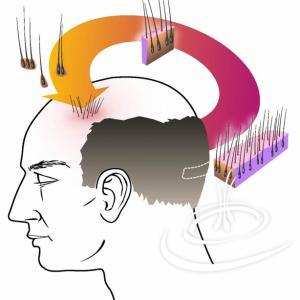Hair Transplant: How Does It Work?
 You need to know that hair from the upper part of the scalp is often scheduled to shrink over time and, in some cases, to disappear. Hair from the posterior part and the sides is almost always resistant hair that will remain the entire life. This genetic reality empowered us to find a solution to baldness or hair loss that men – and women to a lesser extent – can suffer from.
You need to know that hair from the upper part of the scalp is often scheduled to shrink over time and, in some cases, to disappear. Hair from the posterior part and the sides is almost always resistant hair that will remain the entire life. This genetic reality empowered us to find a solution to baldness or hair loss that men – and women to a lesser extent – can suffer from.
For more information about hair loss, we recommend you to consult the page of our website dedicated to the topic by clicking here.
The principle of a hair transplant is simple: it consists in transferring this resistant hair from the back of the scalp to the bald area(s).
To achieve it, the FUT technique was developed and became the first version of hair transplants. It consists in removing a strip from the donor area and to cut it to get follicular grafts that will then be transplanted into the recipient area. This technique enables to reach a high number of grafts in one surgery, but has the disadvantage of leaving a linear scar.
Therefore, in order to satisfy patients who could be disturbed by the idea of a scar, a second technique was developed at the end of the nineties, inspired from the first one: the follicular extraction, or FUE. This technique is different in the extraction method: grafts are indeed removed one by one, which has the advantage to leave few scars (in shape of tiny white dots) but to reduce the number of hairs that can be transplanted in one surgery.
However, you need to keep in mind that the number of grafts available is limited. The fundamental principle which a hair transplant is based on is the notion of apparent density: it is possible to reduce by half an original density without seeing any difference. This principle can be used both for the donor and the recipient areas. We actually reduce the density of the donor area while raising that of the recipient area. The number of hairs remains equal: they do not multiply, they are just transferred.
If you would like to know if you are a good candidate for a hair transplant, you can obtain an online consultation.